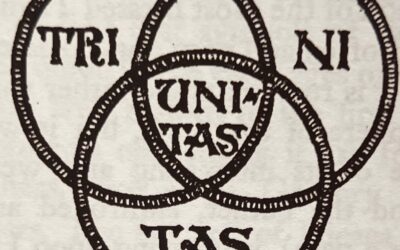Catechesis is the handing on of the Catholic faith, often (but not only) through encyclicals, apostolic constitutions, papal bulls, pastoral letters, homilies, and other written forms.
The Catechism of the Catholic Church says, “In catechesis Christ is taught… anyone teaches to the extent that he is Christ’s spokesman, enabling Christ to teach with his lips.”
Jesus teaches in the Church. He teaches us how to become saints.
The Catholic faith is expressed in formulas
As explained in the book Introduction to the Catechism (Ratzinger and Schonborn), a formula summarizes an essential point of Catholic doctrine. The Catechism says that formulas are statements that “permit us to express the faith and to hand it on.” The writings of the Magisterium, saints, Fathers, and Doctors all include formulas.
This quote from the Catechism is an example of a formula:
All Sacred Scripture is but one book, and that one book is Christ, because all divine Scripture speaks of Christ, and all divine Scripture is fulfilled in Christ.
Hugh of St. Victor
That formula answers this common question: “How did they decide which books to put in the Bible?” Jesus is the essential criterion for the canon of the Sacred Scriptures. Some Scriptures were written before his birth and described what he would say and do. Written after birth, the other scriptures told how he actually did and said what was foretold.
Formulas communicate doctrine. Different composers of doctrine may word a formula in different ways. When you master a formula, you will understand the doctrine it communicates, regardless of its wording. The more formulas you master, the better you will understand and explain the Catholic faith. Your explanations will be correct, and you will often give them in a bold way that is unique to you. You’ll also know when other answers need to be corrected.
Most importantly, you’ll:
- Understand more completely the Church’s liturgy, the privileged place where Christ teaches.
- Learn much more from Holy Scripture, sacred Tradition, and the Magisterium.
- Read and understand the Saints, Church Doctors, and Fathers.
- Make sense of learned commentary about the faith, the sacraments, Christian morality, and prayer.
- Gradually think with the mind of Jesus and, with it, live an enriched, reconciled, purified, nourished, healthy, and righteous life.
There are formulas at the end of each thematic section of the Catechism. The sections are called In Brief. They look like the end-of-chapter summaries found in textbooks but are not. They are a unique feature of great consequence. The Catechism suggests they are worthy of memorization, a Herculean task, because there are 548! As a whole, they teach the entire Catholic faith in about 19,000 words spread over 50 pages. But they are a condensed presentation that needs to be unpacked by skilled hands. Coaching Catholics trains you to master those skills.
We coach you in analyzing formulas’ diction, etymology, terminology, references, and syntax. Then, you can put them into your words and combine them to improvise when communicating your ideas.
What does ‘analyzing formulas’ mean?
During one of the training sessions about the Sacrament of Baptism, we break apart or analyze a number of formulas, and here is one of them:
Christian initiation is accomplished by three sacraments together: Baptism which is the beginning of new life; Confirmation which is its strengthening; and the Eucharist which nourishes the disciple with Christ’s Body and Blood for his transformation in Christ.
Catechism
How do you break apart that formula? First, define the correct sense of the key verbs and nouns hiding in plain sight. Second, ask good questions about the key terms. Third, ask about the formula’s main idea.
Here are the definitions, from the Oxford English Dictionary, of the key verbs and nouns that may be easily overlooked:
- initiation—The action of beginning, entering upon, or ‘starting’ something; the fact of being begun; beginning, commencement, origination.
- accomplished—To fulfill, perform, or carry out successfully (an undertaking, desire, request, etc.); to achieve (one’s object).
- beginning—The action or process of entering upon existence or upon action, or of bringing into existence; commencing, origination.
- strengthening—The action of becoming strong; the fact of being strengthened.
- nourish—To provide with food or sustenance; (gen.) to maintain, support, provide for.
- disciple—A professed follower of Christ; a committed and practicing Christian; (now esp. Christian Church) a person who actively devotes his or her life to following and carrying out Christ’s teachings.
- “transformation—In biology, one of several processes by which genetic material in the form of “naked” deoxyribonucleic acid is transferred between microbial cells. (Britannica)” Transformation is a word being used as an analogy to explain the phrase “transformation in Christ.” In other words, transferring Christ’s divine life to us requires something analogous to energy, and the Eucharist is like the energy for that transformation.
Here are the good questions to ask about the formula’s key terms:
Q1: What is the ‘starting’ of the Christian?
A1: Baptism, Confirmation, and the Eucharist, together, begins Christian life.
Q2: What is the action of Baptism?
A2: Baptism brings Christian life into existence
Q3: What is the action of Confirmation?
A3: Confirmation gives strength to Christian life originating in Baptism.
Q4: What is the act of the Eucharist?
A4: The Eucharist feeds Christian life and is for disciples of Christ, who are the people who professed the faith of Jesus when they were baptized (or who were baptized in the faith of the Church).
Now, we can ask you this question pointing to the formula’s heart: How does the Christian come into being? You would answer,in these or similar words: by Baptism, Confirmation, and the Eucharist, recipients are made into Christian persons. Those three sacraments, together, are the “end of the beginning” of life in Christ. The Eucharist, however, is necessary throughout Christian life because a life needs food to sustain itself.
If you go back and read the formula, you’ll see more than you did. The words have stayed the same, but your comprehension has changed, and you are beginning to see its fullness.
What does ‘combine formulas’ mean?
Each of the four answers above is also a new formula. The analysis of one formula can result in more than a half-dozen new formulas in your own words. You form statements by combining them.
For example, through our coaching and practice, let’s say that you wrote these six simple formulas:
- Sacred Scriptures are what they contain: the Word of God.
- We are assured of the truth of the Scriptures because God is their author.
- Only God’s Spirit can give a complete understanding of Scripture.
- God’s plan to save us is communicated by his deeds and words.
- God’s deeds and words in the Old Testament explain the historical and salvific events in the New Testament.
- The 4 Gospels = Jesus. They are what they contain.
You could combine those formulas in a thoughtful, correct, and meaningful way, similar to this: The Scriptures are what they contain—the Word of God. They are authored by God and interpreted by the Holy Spirit for our salvation. The Scriptures are books organized into the Old and New Testaments. The Gospels are the center of the Scriptures because they are what they contain, Jesus, about whom all the Scriptures speak. God’s deeds and words in the Old Testament point to Jesus Christ and reveal the purpose of his life. The Church venerates the Scriptures because they are what they contain: the Word of God, which is Jesus Christ himself.
What does ‘improvising with formulas’ mean?
Imagine a conversation and hearing someone say that any two consenting adults are free to enjoy sexual activity and the Church should have nothing to say about it. Someone who listened to that and who was doing our training would remember the coaching session about the Sixth Commandment. It presents this formula: “Chastity means the integration of sexuality within the person.” We explore every detail of that and the related formulas.
Our coaching would prepare you to say something on the spot, like this: God’s command, ‘Do not commit adultery,’ confirms chastity, which is the integration of the sex drive within the person so that the virtue and moral law that guide and govern conduct can also guide and govern sexual conduct. The truth is that some behavior wounds us by allowing the sex drive to operate without checks, balances, or regulations.
It takes coaching and practice to master the formulas of the Catholic faith so that you can think, speak, and write with the mind of Jesus. Serious students train.







0 Comments